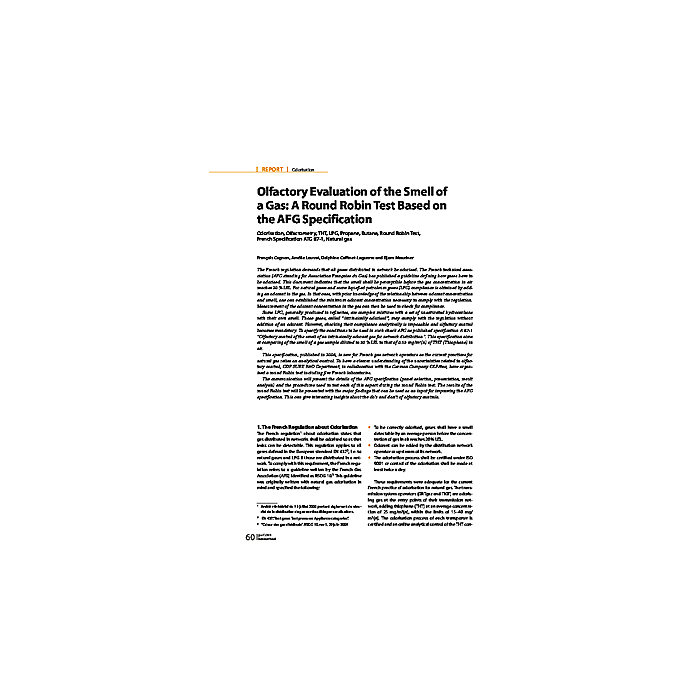Olfactory Evaluation of the Smell of a Gas: A Round Robin Test Based on the AFG Specification
4,90 €
Auf Lager
Artikelnummer
00258_2010_01_07
The French regulation demands that all gases distributed in network be odorised. The French technical association (AFG standing for Association Française du Gaz) has published a guideline defining how gases have to be odorised. This document indicates that the smell shall be perceptible before the gas concentration in air reaches 20 % LEL. For natural gases and some liquefied petroleum gases (LPG) compliance is obtained by adding an odorant in the gas. In that case, with prior knowledge of the relationship between odorant concentration and smell, one can established the minimum odorant concentration necessary to comply with the regulation. Measurement of the odorant concentration in the gas can then be used to check for compliance. Some LPG, generally produced in refineries, are complex mixtures with a set of unsaturated hydrocarbons with their own smell. Those gases, called "intrinsically odorised", may comply with the regulation without addition of an odorant. However, checking their compliance analytically is impossible and olfactory control becomes mandatory. To specify the conditions to be used in such check AFG as published specification A 87-1 "Olfactory control of the smell of an intrinsically odorant gas for network distribution". This specification aims at comparing of the smell of a gas sample diluted to 20 % LEL to that of 0.15 mg/m3(n) of THT (Thiophane) in air. This specification, published in 2006, is new for French gas network operators as the current practices for natural gas relies on analytical control. To have a clearer understanding of the uncertainties related to olfactory control, GDF SUEZ R and D Department, in collaboration with the German Company OLFAtec, have organized a round Robin test including five French laboratories. The communication will present the details of the AFG specification (panel selection, presentation, result analysis) and the procedures used to test each of this aspect during the round Robin test. The results of the round Robin test will be presented with the major findings that can be used as an input for improving the AFG specification. This can give interesting insights about the do's and don't of olfactory controls.
| Autoren | François Cagnon/Amélie Louvat/Delphine Coffinet-Laguerre and Bjorn Maxeiner |
|---|---|
| Erscheinungsdatum | 01.01.2010 |
| Format | |
| Zeitschrift | gas for energy - Issue 01 2010 |
| Verlag | DIV Deutscher Industrieverlag GmbH |
| Sprache | English |
| Seitenzahl | 7 |
| Titel | Olfactory Evaluation of the Smell of a Gas: A Round Robin Test Based on the AFG Specification |
| Beschreibung | The French regulation demands that all gases distributed in network be odorised. The French technical association (AFG standing for Association Française du Gaz) has published a guideline defining how gases have to be odorised. This document indicates that the smell shall be perceptible before the gas concentration in air reaches 20 % LEL. For natural gases and some liquefied petroleum gases (LPG) compliance is obtained by adding an odorant in the gas. In that case, with prior knowledge of the relationship between odorant concentration and smell, one can established the minimum odorant concentration necessary to comply with the regulation. Measurement of the odorant concentration in the gas can then be used to check for compliance. Some LPG, generally produced in refineries, are complex mixtures with a set of unsaturated hydrocarbons with their own smell. Those gases, called "intrinsically odorised", may comply with the regulation without addition of an odorant. However, checking their compliance analytically is impossible and olfactory control becomes mandatory. To specify the conditions to be used in such check AFG as published specification A 87-1 "Olfactory control of the smell of an intrinsically odorant gas for network distribution". This specification aims at comparing of the smell of a gas sample diluted to 20 % LEL to that of 0.15 mg/m3(n) of THT (Thiophane) in air. This specification, published in 2006, is new for French gas network operators as the current practices for natural gas relies on analytical control. To have a clearer understanding of the uncertainties related to olfactory control, GDF SUEZ R and D Department, in collaboration with the German Company OLFAtec, have organized a round Robin test including five French laboratories. The communication will present the details of the AFG specification (panel selection, presentation, result analysis) and the procedures used to test each of this aspect during the round Robin test. The results of the round Robin test will be presented with the major findings that can be used as an input for improving the AFG specification. This can give interesting insights about the do's and don't of olfactory controls. |
Eigene Bewertung schreiben


